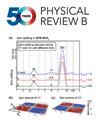Strongly interacting bosons in a one-dimensional disordered lattice: Phase coherence of distorted Mott phases
IF 3.7
2区 物理与天体物理
Q1 Physics and Astronomy
引用次数: 0
Abstract
We explore the consequences of disorder on phase coherence in the Mott insulator phases in an optical lattice. Few bosons with contact interaction in small optical lattice can feature varieties of insulating phases—weakly interacting Mott in deep lattice, maximally fragmented and strongly interacting Mott in intermediate lattice, weak Mott with double filling and intrawell coherence, fermionized Mott with strong intrawell coherence. Utilization of the multiconfigurational time-dependent Hartree method for bosons to solve the many-boson Schrödinger equation, facilitates to understand the microscopic effect of disorder on the different kinds of Mott phases in the primary lattice. The many-body properties are analyzed by distinct measures of the reduced one-body density in real and momentum space, fragmentation, order parameter, variance of spatial single-shot measurements, compressibility, and the Glauber normalized correlation functions. We find very complex competition of localization due to disorder and Mott correlation. We observe distinct response of four different Mott phases in the disordered lattice. When the weakly interacting Mott exhibits the Bose glass phase, the strongly correlated and fully fragmented Mott exhibits leakage, melting and central localization. In contrast, weak Mott with double filling which is a spatially separated dimer in each site, exhibits only some dissociation of intrawell coherence and assist in the development of interwell coherence in the presence of strong disorder. For the fermionized Mott, when the density in each well is fragmented, strong disorder interferes with the intrawell correlation and the characteristic dip in each site starts to disappear leading to simple Mott localization with a pair of bosons.一维无序晶格中的强相互作用玻色子:扭曲莫特相的相干性
我们探讨了无序对光学晶格中莫特绝缘体相位相干性的影响。在小型光晶格中具有接触相互作用的少数玻色子可以产生多种绝缘体相--深晶格中的弱相互作用莫特相、中间晶格中的最大碎片和强相互作用莫特相、具有双重填充和晶胞内相干性的弱莫特相、具有强晶胞内相干性的费米子化莫特相。利用玻色子的多构型时间相关哈特里方法求解多玻色子薛定谔方程,有助于理解无序对初级晶格中不同类型莫特相的微观影响。我们通过实空间和动量空间的还原单体密度、碎片、阶次参数、空间单次测量的方差、可压缩性以及格劳伯归一化相关函数等不同测量方法分析了多体特性。我们发现无序和莫特相关导致的局部化竞争非常复杂。我们观察到无序晶格中四种不同莫特相的不同反应。当弱相互作用的莫特表现出玻色玻璃相时,强相关和完全破碎的莫特表现出泄漏、熔化和中心局域化。与此相反,具有双填充的弱莫特(每个位点上都有一个空间上分离的二聚体)在强无序的情况下只表现出井内相干性的一些解离,并有助于井间相干性的发展。对于费米化莫特,当每个孔中的密度被分割时,强无序会干扰孔内相关性,每个位点的特征凹陷开始消失,从而导致一对玻色子的简单莫特局域化。
本文章由计算机程序翻译,如有差异,请以英文原文为准。
求助全文
约1分钟内获得全文
求助全文
来源期刊

Physical Review B
物理-物理:凝聚态物理
CiteScore
6.70
自引率
32.40%
发文量
0
审稿时长
3.0 months
期刊介绍:
Physical Review B (PRB) is the world’s largest dedicated physics journal, publishing approximately 100 new, high-quality papers each week. The most highly cited journal in condensed matter physics, PRB provides outstanding depth and breadth of coverage, combined with unrivaled context and background for ongoing research by scientists worldwide.
PRB covers the full range of condensed matter, materials physics, and related subfields, including:
-Structure and phase transitions
-Ferroelectrics and multiferroics
-Disordered systems and alloys
-Magnetism
-Superconductivity
-Electronic structure, photonics, and metamaterials
-Semiconductors and mesoscopic systems
-Surfaces, nanoscience, and two-dimensional materials
-Topological states of matter
 求助内容:
求助内容: 应助结果提醒方式:
应助结果提醒方式:


